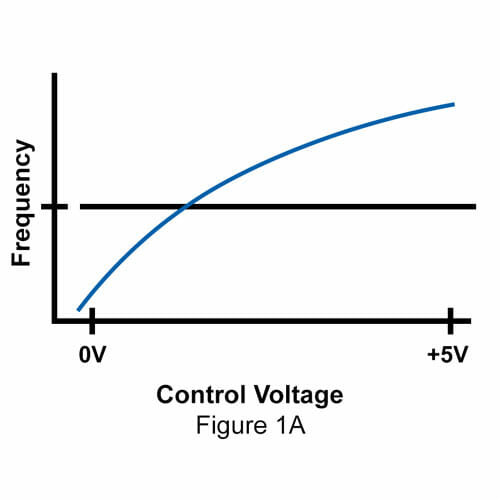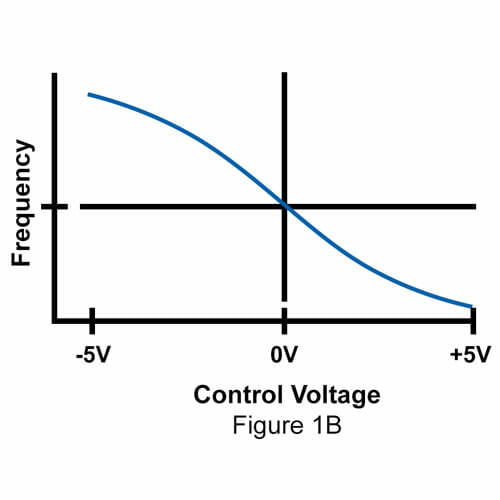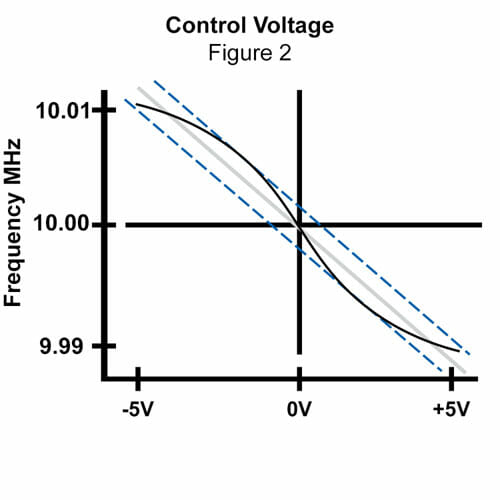
Written by David Meaney, Vice President of Global Technical Sales and Marketing at ECS Inc. International
What is a VCXO?
A VCXO is a crystal oscillator whose output frequency varies based on an applied control voltage. The variation of a VCXO’s output frequency is specified in parts per million (ppm) and is called pullability, total pulling range, or absolute pull range (APR) if stability and aging are included in the calculation. A VCXO consists of a crystal and an oscillator circuit with a varactor diode and supporting circuitry. The high Q (Quality) factor of quartz allows a small range of frequency pulling. They also offer high performance with low jitter and low phase noise.
VCXOs are used for fine adjustment of the operating frequency and are normally used in conjunction with a phase locked loop (PLL). The amount of pullability in a VCXO can vary. Some only require 50ppm of pull, while others may require many hundreds ppm of pull. Some applications for VCXOs include telecom, test and measurement, and broadcast equipment.
What is Pullability?
The pullability is the frequency range over which the VCXO can be pulled for a given change in control voltage. It is specified in terms of parts per million (ppm) for a given voltage. As is expected, large pullability figures give a larger tuning range, but VCXOs with smaller levels of pullability offer greater stability and lower phase noise.
What is Absolute Pulling Range?
Absolute Pulling Range (APR) is the minimum guaranteed deviation of the VCXO from the center frequency when the control voltage is set to the maximum and minimum values. APR can be calculated by subtracting the errors in frequency caused by temperature, quartz aging, power supply, and circuit load from the total pulling range.
In this example, the total pull range of the oscillator is ±160 ppm when inaccuracies and external effects are calculated out. The resulting APR that is available to use is ±100 ppm.

What is the difference between a VCO and a VCXO?
A VCO or voltage-controlled oscillator is an electronic oscillator whose output frequency is generated using an electronic circuit. They can be used for frequency modulation (FM) or phase modulation (PM) by applying a modulating signal to the control input. A VCO is also an integral part of a phase-locked loop. VCOs are used in synthesizers to generate a waveform whose pitch can be adjusted by a voltage determined by a musical keyboard or other input.
A VCXO is a voltage-controlled crystal oscillator consisting of a crystal oscillator, a varactor diode, and supporting circuitry. The output frequency of a VCXO is determined by the properties of the crystal. When a varying DC voltage is applied across the crystal, the oscillation frequency changes. VCXOs are commonly found in networking and communication and test equipment.
VCO
- Oscillation frequency generated by an electronic circuit
- Wide frequency pull range
- Not very stable
- Poor phase noise
VCXO
- Oscillation frequency generally based on crystal properties
- Narrow frequency pull range
- Capable of tight stabilities
- Very good phase noise
There are several characteristics that are specific to VCXOs. When configuring a VCXO the first step is to characterize the base oscillator performance to ensure the VCXO can be frequency tuned enough to meet the circuit requirements. These specs will include operating frequency, temperature range, and stability. For the voltage-controlled portion, there needs to be the following:
Control Voltage – This is the varying voltage which is applied to the VCXO input pin causing a change in frequency. It is sometimes referred to as Modulation Voltage, especially if the input is an AC signal.
Deviation – This is the amount of frequency change which results from changes in control voltage. For example, a 0V ~ 5V control voltage might result in a deviation of ±150 ppm. Once APR is calculated it might result in usable deviation of ±100 ppm.
Transfer function (sometimes referred to as Slope Polarity) – This defines the direction of frequency change vs applied control voltage. A positive transfer function would result in an increase in frequency as in Figure 1A. A negative transfer function would result in a decrease in frequency with a more positive (or less negative) control voltage, as in Figure 1B.


Linearity – As outlined in MIL-PRF-55310, it is the ratio between frequency error and total deviation, expressed in percent, where frequency error is the maximum frequency excursion from the best straight line drawn through a plot of output frequency vs control voltage.
If the specification for an oscillator requires a linearity of ±5% and the actual deviation is 20 kHz total, as shown in Figure 2, the curve of output frequency vs control voltage input could vary ±1 kHz (20 kHz ±5%) from the middle grey line. These limits are shown by the blue dashed lines, and the black curved line represents the typical curve of a VCXO exhibiting a linearity within ±5%.

Good VCXO design dictates that the voltage to frequency curve be smooth (no discontinuities) and monotonic.
Other Design Considerations
Stability – A quartz crystal is a high Q device which is the crystal oscillator’s stability determining element. It inherently resists being “pulled” from its fundamental frequency. To produce a VCXO with significant deviation, the oscillator circuit must be degraded or “de-Q’d”. This results in the loss of inherent stability of the crystal in terms of its frequency vs temperature characteristic, its aging characteristic, and its short-term stability characteristic. This will also affect the associated jitter and phase noise performance. It is in the engineer’s best interest not to specify a wider deviation than is necessary.
Phase Locking – When a VCXO is used in a phase-locked loop application, the deviation should always be equal to or greater than the combined instability of the VCXO itself and the reference or signal onto which it is being locked. If the open loop stability requirements are more stringent, a TC/VCXO may be used to satisfy higher open loop requirements.
Whether you are in the market for a high-quality VCXO or any other type of crystal oscillator, ECS Inc. can offer any solution for your timing needs.
For more technical resources, please reference our library of technical guides, educational video library on frequency control and product information, our reference design library or our current product catalog.
Please contact us if you need additional information or have a specific requirement in your application.
ECS Inc. International
15351 West 109th Street
Lenexa, KS 66219
Tel: 913-782-7787
Toll Free: 1-800-237-1041
Fax: 913-782-6991